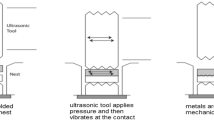Abstract
The battery of an electronic vehicle consists of hundreds or thousands of battery cells. Since each battery cell is electrically connected to each other, the quality of the battery depends on the performance of welded joint. Ultrasonic welding is a solid-state process that is possible to apply to secondary batteries assemble due to its low electrical resistance and wide joint area in a short time. In the present study, a 0.3 mm thick aluminum for tab material and a 1.0 mm thick copper for busbar material were welded by ultrasonic welding. The aluminum was placed at the sonotrode side, and copper was positioned at the anvil side, respectively. The effect of process parameters such clamping pressure, amplitude of vibration and welding time on joint characteristics was investigated. As a result, it was observed that depth of indentation significantly increased with increasing welding time compared to clamping pressure. The normal-welded morphology was formed at welding time of 0.3 s and then the maximum tensile shear load was 0.93 kN, which is the highest.










Similar content being viewed by others
Change history
12 December 2022
A Correction to this paper has been published: https://doi.org/10.1007/s12541-022-00748-6
References
Macwan, A., & Chen, D. L. (2015). Microstructure and mechanical properties of ultrasonic spot welded copper-to-magnesium alloy joints. Materials & Design, 84, 261–269.
Genevois, C., Girard, M., Huneau, B., Sauvage, X., & Racineux, G. (2011). Interfacial reaction during friction stir welding of Al and Cu. Metallurgical and Materials Transactions A, 42(8), 2290–2295.
Macwan, A., Patel, V. K., Jiang, X. Q., Li, C., Bhole, S. D., & Chen, D. L. (2014). Ultrasonic spot welding of Al/Mg/Al tri-layered clad sheets. Material & Design, 62, 344–351.
Panteli, A., Robson, J. D., Brough, I., & Prangnell, P. B. (2012). The effect of high strain rate deformation on intermetallic reaction during ultrasonic welding aluminium to magnesium. Materials Science and Engineering: A, 556, 31–42.
Lee, S. S., Kim, T. H., Hu, S. J., Cai, W., & Abell, J. A. (2010). Joining technologies for automotive lithium-ion battery manufacturing: A review. Proceedings of the ASME 2010 International Manufacturing Science and Engineering Conference, Vol. 1, pp. 541–549.
Schmalen, P., Mathivanan, K., & Plapper, P. (2019). Metallographic studies of dissimilar Al-Cu laser-welded joints using various etchants. Metallography, Microstructure, and Analysis, 8, 3–11.
Das, A., Li, D., Williams, D., & Greenwood, D. (2018). Joining technologies for automotive battery systems manufacturing. World Electric Vehicle Journal, 9(2), 22.
Zhao, Y. Y., Li, D., & Zhang, Y. S. (2013). Effect of welding energy on interface zone of Al–Cu ultrasonic welded joint. Science and Technology of Welding and Joining, 18, 354–360.
Satpathy, M. P., & Sahoo, S. K. (2017). Mechanical performance and metallurgical characterization of ultrasonically welded dissimilar joints. Journal of Manufacturing Processes, 25, 443–451.
Kang, M. J., & Lee, K. H. (2020). Influence of welding variables on indentation depth in ultrasonically welded Al/Cu dissimilar joints and theoretical fracture load estimation. Journal of Welding and Joining, 38(3), 289–294.
Das, A., Masters, I., & Williams, D. (2019). Process robustness and strength analysis of multi-layered dissimilar joints using ultrasonic metal welding. The International Journal of Advanced Manufacturing Technology, 101, 881–900.
Xin, W., Liu, T., & Cai, W. (2015). Microstructure, welding mechanism, and failure of Al/Cu ultrasonic welds. Journal of Manufacturing Processes, 20(3), 515–524.
Shakil, M., Tariq, N. H., Ahmad, M., Choudhary, M. A., Akhter, J. I., & Babu, S. S. (2014). Effect of ultrasonic welding parameters on microstructure and mechanical properties of dissimilar joints. Materials & Design, 55, 263–273.
Das, A., Barai, A., Masters, I., & Williams, D. (2019). Comparison of tab-to-busbar ultrasonic joints for electric vehicle li-ion battery applications. World Electric Vehicle Journal, 10(3), 55.
Lee, S. S., Kim, T. H., Hu, S. J., Cai, W., Abell, J. A., & Li, J. J. (2013). Characterization of joint quality in ultrasonic welding of battery tabs. Journal of Manufacturing Science and Engineering, 135(2), 021004.
Das, S., Satpathy, M. P., Routara, B. C., & Sahoo, S. K. (2020). Microstructural and joint analysis of ultrasonic welded aluminum to Cupro-Nickel sheets for lithium-ion battery packs. Material Science Forum, 978, 463–469.
Yang, J. W., Cao, B., He, C., & Luo, H. S. (2014). Microstructure evolution and mechanical properties of Cu–Al joints by ultrasonic welding. Science and Technology of Welding and Joining, 19(6), 500–504.
Kim, T. H., Yum, J., Hu, S. J., Spicer, J. P., & Abell, J. A. (2011). Process robustness of single lap ultrasonic welding of thin, dissimilar materials. CIRP Annals, 60(1), 17–20.
Ma, A., Roters, F., & Raabe, D. (2006). On the consideration of interactions between dislocations and grain boundaries in crystal plasticity finite element modeling–Theory, experiments, and simulations. Acta Materialia, 54(8), 2181–2194.
Acknowledgements
This research was supported by Basic Science Research Program through the National Research Foundation of Korea (NRF) funded by the Ministry of Education (No. 2020R1I1A3055274).
Author information
Authors and Affiliations
Corresponding author
Additional information
Publisher's Note
Springer Nature remains neutral with regard to jurisdictional claims in published maps and institutional affiliations.
Rights and permissions
Springer Nature or its licensor (e.g. a society or other partner) holds exclusive rights to this article under a publishing agreement with the author(s) or other rightsholder(s); author self-archiving of the accepted manuscript version of this article is solely governed by the terms of such publishing agreement and applicable law.
About this article
Cite this article
Go, BS., Kim, KH., Ro, CS. et al. Influence of Process Parameters on Formation of Al/Cu Dissimilar Weld Using Ultrasonic Welding. Int. J. Precis. Eng. Manuf. 23, 1359–1365 (2022). https://doi.org/10.1007/s12541-022-00651-0
Received:
Revised:
Accepted:
Published:
Issue Date:
DOI: https://doi.org/10.1007/s12541-022-00651-0




